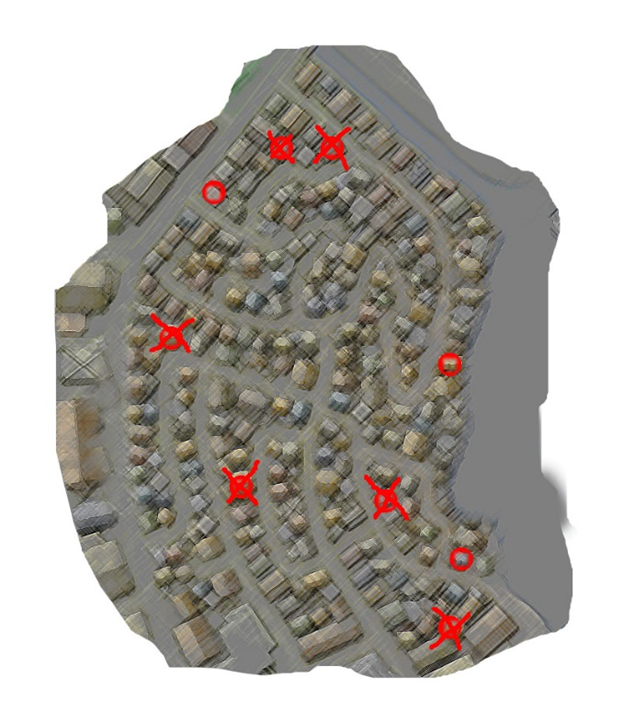DISCUSSING
In the Shadow of the Spire – Session 39B: Shivvel, Slaves, and Gold
“If they’re running a major drug operation here, this isn’t nearly enough money.”
It was clear, too, that there had once been much more of the shivvel stored here. Tee suspected that the destruction of Linech Cran’s operation was continuing to affect the ratlings’ supply.
Poking around the rest of the room she discovered that a section of the wall could be removed, revealing a detailed map of the Warrens with several locations marked with crude symbols.
When discussing node-based design, a lot of focus tends to be put on how it can be used for scenarios like the 5-node mystery. Which makes sense. It’s a very versatile scenario structure, easy to use and adaptable to a lot of different situations.
But I first came to node-based design as a campaign structure, as described in Node-Based Campaigns: Not linking together scenes in an adventure, but as a way of linking one adventure to another. In the Shadow of the Spire, a campaign I was actually running and designing when I wrote Node-Based Scenario Design, is almost entirely built using a node-based campaign structure.
You can see a pretty focused example of what that looks like in the current adventure.
I labeled each adventure with an alphanumeric code. So the PCs are currently in CC01 Temple of the Rat God. The “CC” stands for “Chaos Cults.” Act II of the campaign also includes BW and NOD adventures, for Banewarrens and Night of Dissolution, respectively. The distinction of “BW” adventures reflects that Act II of the campaign is built around two separate forks (the chaos cults and the Banewarrens), while having “NOD” and “CC” designators started as a convenient way of distinguishing “stuff from the Night of Dissolution campaign book” from the wide variety of additional chaos cult scenarios I was adding to the campaign.
But why have alphanumeric codes at all?
Mostly convenience and clarity.
For example, it made it easy to say that the Marked Map of the Warrens handout (as seen below) was pointing to CC01A Warren Shivel Dens.

Why “CC01A” instead of “CC02” or some other distinct number? Again, it mostly boils down to what I found most useful. I generally found it useful to group together scenarios that were more closely related to each other. For example, the adventures found in Ptolus Remix: The Mrathrach Agenda were originally NOD5 Mrathrach Machine and NOD5A The White House.
The warren shivvel dens directly operated by the ratling cultists were more closely/directly related to CC01 Temple of the Rat God than they were to, for example, CC07 Porphyry House of Horrors. In this case, I’d also “discovered” the warren shivvel dens existed while prepping CC01 Temple of the Rat God, so it just made sense to me to insert them into the numbering sequence here.
Other clues the PCs found here include:
- Sewer Routes to the Coast, a map which is an alternate clue to CC01A and also to 004A Slaver’s Enclave (an adventure from Act I).
- Questioning the slaves, which would also lead to 004A Slaver’s Enclave.
- Sewer Tunnels to Oldtown, a map leading to NOD4 Temple of Deep Chaos.
- Broken square symbols forming a trail in the sewer tunnels, which could be followed to CC02 Temple of the Ebon Hand.
And here you can directly see the dynamics of a node-based campaign in play. Having found all these clues, the PCs have to make a decision about which lead they’re going to pursue next. (And, in this case, that actually includes, “Do we keep exploring the dungeon we’re in? Or do we switch gears?”) The players are immediately drawn into this discussion (at least in part because they’re collectively puzzling out what the clues mean and how they’re connected to things they’ve learned elsewhere in the campaign), causing the group to collectively think deeply about the campaign and get drawn further into the game world.
Also, because of the redundancy of the Inverted Three Clue Rule, it would also have been fine if, for example, they didn’t question the slaves…
…which, from a structural standpoint, they didn’t.
Ranthir, meanwhile, was feeding the malnourished slaves while Tor gently questioned them. It turned out that most of them had been freshly captured off the streets of Ptolus, many from the Warrens. Several were obviously shivvel addicts and easily preyed on. There was an elven prisoner, however, who had a different tale to tell: He had lived in the village of Onsafal in the Teeth of Light. He and most (if not all) of his village were captured by slavers and then sold through the black markets of Freeport. He had arrived at the Docks, been taken to a warehouse, and then sold to the ratlings.
Ranthir heard from one of the slaves how they’d been kidnapped and taken to a warehouse in the Docks, but he never followed up by asking the elf where the warehouse was located. (A classic example of a player not realizing that a clue is actually a clue.)
In fact, as the campaign continues, you’ll discover that the PCs didn’t follow MOST of these clues.
There are a variety of reasons for this. For example, the redundancy between the Sewer Tunnels to Oldtown map and the Marked Map of the Warrens caused them to conflate the two. They chose to approach the shivvel dens above ground, and ended up ignoring the fact that Sewer Tunnels to Oldtown also included a tunnel leading to the Docks (and the warehouse the elf had mentioned).
(It’s particularly fun when something like this happens, they eventually find a different path, and then many moons later they’re reviewing their notes, discover the clue they ignored, and say, “Holy crap! We had the solution the whole time!”)
There are a few other connections to note.
The shivvel they find here is a payoff from previous foreshadowing. Way back in Session 9, the PCs had found a note indicating that Silion was getting shipments of shivvel from Linech Cran. This was an existential lead, as described in Running Mysteries: The Two Types of Leads – it told the PCs that Silion existed, but didn’t give them any way of actually finding her. That foreshadowing set up Silion as an antagonist, and here we complete the circuit.
The Deathmantle cult symbol the PCs find here is the opposite end of the same thing: The PCs learn the Deathmantle cult exists, but have no way of finding them right now.

The evidence that the cultists are having problems sourcing shivvel (which is further developed in CC01A) because the PCs took out Linech Cran’s shivvel operation is another form of payoff, this time showing the impact of the PCs’ actions on the game world.
Along similar lines, in Session 39C the PCs also find a note indicating that the Temple of the Rat God had begun investigating the Arathian Job, giving them a well-earned pat on the back for a job well done, while also making them just slightly paranoid that the cultists were on their trail.
Don’t worry: A little paranoia is good for the players.
Campaign Journal: Session 39C – Running the Campaign: Reputation
In the Shadow of the Spire: Index













I got interested in the structure behind a node-based campaign after reading chapter 2 of your book. Glad to see you explaining it a bit further here. My question is how the individual scenario hooks work inside the structure. Are they the clues between scenarios or the first scene of every scenario? Are they the fuel that keeps the intention alive so the characters have a reason to look for and follow clues in the first place? Am I just overthinking?
I mean, in Mephits & Magmin, there is a specific section called “scenario hook”. But in a node-based campaign is it necessary since there are clues linking everything?
Yes, the clues in the other adventures would be the hooks.
You could have a separate proactive hook (that would come find the PCs regardless), and you might include that in your adventure notes (and then probably schedule it on your campaign status document timeline), but if I’ve got a scenario that’s integrated into a node-based structure, i would generally just let the structure take care of it.
You could, hypothetically, include a “Hooks” section in your adventure notes that would summarize all of the places you’ve placed leads pointing at the adventure. (What I do instead is maintain a Campaign Revelations List — essentially a list of scenarios with the leads listed as bullet points. I can see the whole campaign in one document; often on just one or two pages.)
Great article. I am new to RPGs and having been consuming the info on your site for the past 24hrs.
I do have a question though. Do you have an article or video where you go through an example campaign from scratch, using all the tools, tips, and tricks you written about?
I think sometimes I’m having a difficult time Conceptualizing exactly how to put all this into practice.
Do I need to ideally become a Patreon member to make this happen?
Thanks!